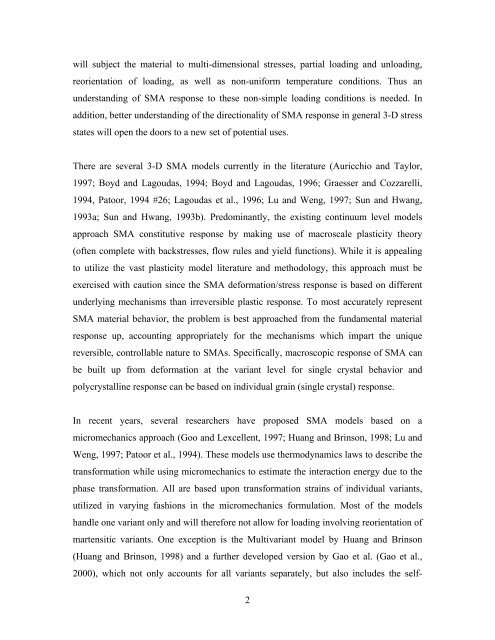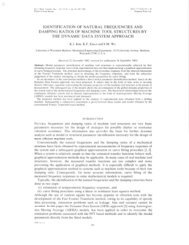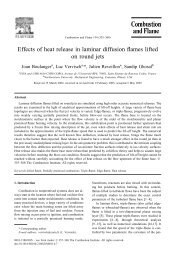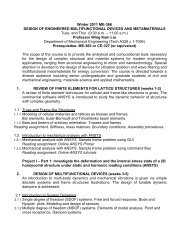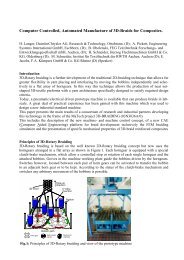A Simplified Multivariant SMA Model Based on Invariant Plane ...
A Simplified Multivariant SMA Model Based on Invariant Plane ...
A Simplified Multivariant SMA Model Based on Invariant Plane ...
Create successful ePaper yourself
Turn your PDF publications into a flip-book with our unique Google optimized e-Paper software.
will subject the material to multi-dimensi<strong>on</strong>al stresses, partial loading and unloading,<br />
reorientati<strong>on</strong> of loading, as well as n<strong>on</strong>-uniform temperature c<strong>on</strong>diti<strong>on</strong>s. Thus an<br />
understanding of <str<strong>on</strong>g>SMA</str<strong>on</strong>g> resp<strong>on</strong>se to these n<strong>on</strong>-simple loading c<strong>on</strong>diti<strong>on</strong>s is needed. In<br />
additi<strong>on</strong>, better understanding of the directi<strong>on</strong>ality of <str<strong>on</strong>g>SMA</str<strong>on</strong>g> resp<strong>on</strong>se in general 3-D stress<br />
states will open the doors to a new set of potential uses.<br />
There are several 3-D <str<strong>on</strong>g>SMA</str<strong>on</strong>g> models currently in the literature (Auricchio and Taylor,<br />
1997; Boyd and Lagoudas, 1994; Boyd and Lagoudas, 1996; Graesser and Cozzarelli,<br />
1994, Patoor, 1994 #26; Lagoudas et al., 1996; Lu and Weng, 1997; Sun and Hwang,<br />
1993a; Sun and Hwang, 1993b). Predominantly, the existing c<strong>on</strong>tinuum level models<br />
approach <str<strong>on</strong>g>SMA</str<strong>on</strong>g> c<strong>on</strong>stitutive resp<strong>on</strong>se by making use of macroscale plasticity theory<br />
(often complete with backstresses, flow rules and yield functi<strong>on</strong>s). While it is appealing<br />
to utilize the vast plasticity model literature and methodology, this approach must be<br />
exercised with cauti<strong>on</strong> since the <str<strong>on</strong>g>SMA</str<strong>on</strong>g> deformati<strong>on</strong>/stress resp<strong>on</strong>se is based <strong>on</strong> different<br />
underlying mechanisms than irreversible plastic resp<strong>on</strong>se. To most accurately represent<br />
<str<strong>on</strong>g>SMA</str<strong>on</strong>g> material behavior, the problem is best approached from the fundamental material<br />
resp<strong>on</strong>se up, accounting appropriately for the mechanisms which impart the unique<br />
reversible, c<strong>on</strong>trollable nature to <str<strong>on</strong>g>SMA</str<strong>on</strong>g>s. Specifically, macroscopic resp<strong>on</strong>se of <str<strong>on</strong>g>SMA</str<strong>on</strong>g> can<br />
be built up from deformati<strong>on</strong> at the variant level for single crystal behavior and<br />
polycrystalline resp<strong>on</strong>se can be based <strong>on</strong> individual grain (single crystal) resp<strong>on</strong>se.<br />
In recent years, several researchers have proposed <str<strong>on</strong>g>SMA</str<strong>on</strong>g> models based <strong>on</strong> a<br />
micromechanics approach (Goo and Lexcellent, 1997; Huang and Brins<strong>on</strong>, 1998; Lu and<br />
Weng, 1997; Patoor et al., 1994). These models use thermodynamics laws to describe the<br />
transformati<strong>on</strong> while using micromechanics to estimate the interacti<strong>on</strong> energy due to the<br />
phase transformati<strong>on</strong>. All are based up<strong>on</strong> transformati<strong>on</strong> strains of individual variants,<br />
utilized in varying fashi<strong>on</strong>s in the micromechanics formulati<strong>on</strong>. Most of the models<br />
handle <strong>on</strong>e variant <strong>on</strong>ly and will therefore not allow for loading involving reorientati<strong>on</strong> of<br />
martensitic variants. One excepti<strong>on</strong> is the <str<strong>on</strong>g>Multivariant</str<strong>on</strong>g> model by Huang and Brins<strong>on</strong><br />
(Huang and Brins<strong>on</strong>, 1998) and a further developed versi<strong>on</strong> by Gao et al. (Gao et al.,<br />
2000), which not <strong>on</strong>ly accounts for all variants separately, but also includes the self-<br />
2


